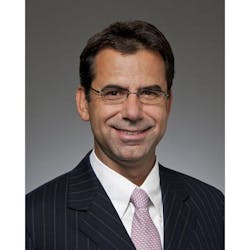Having taken the helm of the Industry Sector at Siemens just 8 months ago, Dr. Helmuth Ludwig has seen a world of change in that time. Amid the political and economic turmoil that has impacted the business world so dramatically prior to and since his appointment as CEO, Dr. Ludwig says the biggest surprise to him has been the renaissance of manufacturing in the U.S.
If you think back just 12 to 18 months ago, manufacturing was not a core topic in the minds of the U.S. business world, Ludwig said. Because of this, he is amazed at how quickly the mindset around the importance of manufacturing in the U.S. has changed.
“It all reminds me when I completed graduate school in Chicago and I told my fellow students I was going to work for Siemens,” he recalled. “They were puzzled. Most of them were unfamiliar with Siemens and they told me that the real future was on Wall Street. Of course, this has all changed so radically. Now when I return and talk to students there, I hear that engineering and manufacturing is a core topic for them, and an attractive one in terms of a career choice. And they also know about Siemens now, too.”
Gas, cash and apprentices
Ludwig says that the price of gas price is a big, if not the biggest, driver to the resurgence of manufacturing in the U.S. because of its effect on energy prices as well as the boost it is giving to certain manufacturing sectors. “We’ve more than doubled the size of our Charlotte facility that produces gas turbines,” he said. “This is an important investment for Siemens and we did it because we believe there will be a continued development of gas-based power stations. But the stability of gas prices is important to this.”
The availability of cash for investing is another major driver of manufacturing’s resurgence, according to Ludwig. “Now, more than at any time since the late 1950s, corporations have a great deal of cash available for investment — somewhere around $2.2 trillion is available for investment now on the balance sheets of companies.”
Despite this, investment is not what it could be due to the high level of global economic uncertainty. “Some industries are clearly doing better than others right now,” said Ludwig. “Automotive, aerospace and the oil & gas industries are doing very well, as is mining equipment, especially in North America. But the U.S. is not isolated from what’s going on in the rest of the world, so there remains questions about companies’ eagerness to invest, despite their clear ability to do so based purely on their balance sheets.”
Underscoring Ludwig’s opinion about an increased willingness to invest in manufacturing are discussions he is having with Siemens’ customers and partners in the manufacturing industries. He says the industry’s perception of the itself as a whole has definitely change in the past few years and most everyone is now in agreement that manufacturing must be boosted in the U.S. “Everyone is realizing we cannot be just a service economy; we have to have a solid base of manufacturing as well,” he said. “All of our customers in the manufacturing industries are talking more and more about locating manufacturing operations in the U.S.”
In line with this sentiment, Ludwig says he has noticed an increased interest among U.S. manufacturing companies in the German apprenticeship system.
“This practice of apprenticeship is a core element to the success of manufacturing that needs to be developed for the next generation of manufacturing’s workforce,” Ludwig said. “Some companies have already started their own pilot programs around this. They recognize the importance of it and that they can’t wait for the education system or government to adapt. Ultimately, it’s about competitiveness.”
The business of sustainability
“Sustainability is a topic that comes up again and again and again … across the industry,” Ludwig said as he discussed the seriousness with which Siemens approaches its own sustainability goals and its top ranking on the Dow Jones Sustainability Index. (Note: In 2011, Siemens AG was ranked the most sustainable company in its industry for the fourth year in a row in the Diversified Industrials category of the Dow Jones Sustainability Index.)
“Five years ago, we stated that our goal was to decrease energy and water use by 20 percent relative to sales within five years,” said Ludwig. “By year-end 2011, Siemens had reduced its energy use by 22 percent and water use by 33 percent. This is important for our customers to see that we do this ourselves in our manufacturing operations and in our offices. We take the Dow Jones Sustainability Index very seriously.”
Ludwig noted, however, that some companies — especially mid-sized and smaller companies — still have a difficulty putting together a cohesive program around sustainability that “incorporates ecology and economy.”
One sustainability effort Ludwig has seen take hold in mid-sized companies is conducted through a bottom-up approach.
Explaining this concept, Ludwig spoke of a visit to a mid-sized engine manufacturer whose sustainability program was focused on encouraging workers to share energy saving ideas. In the program, 50 percent of the savings from any viable energy saving idea would be deposited into an account for the first two years of the idea’s implementation. The employees are then allowed to decide which social or community program on which the savings will be spent.
“I thought this was an incredibly interesting combination of sustainability and community involvement,” said Ludwig. “The program worked well for the company and provided an interesting bottom-up approach around which a company’s can begin to effectively build a sustainability program.”

